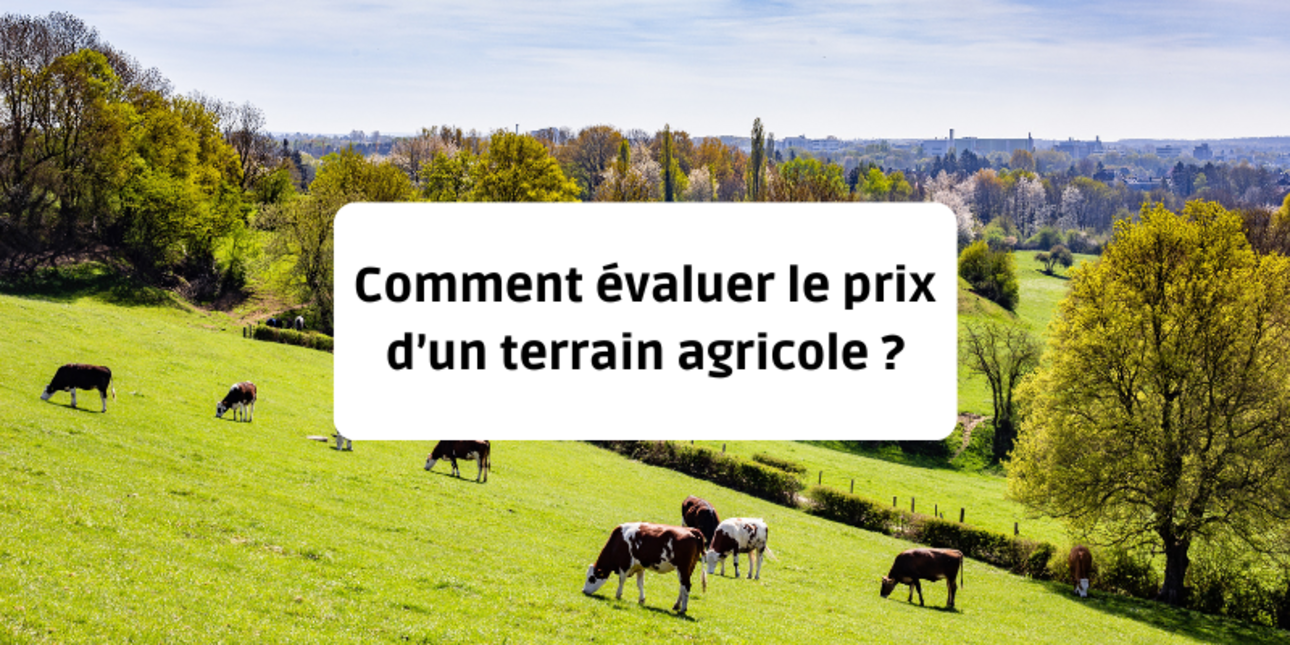
How do you set the sale price of a plot of land? Should a discount be applied if the property is rented? Can I set my own selling price? What impact do PBOs have on land valuation? These are just some of the questions we are regularly asked. Here's an overview of the factors to consider.
Each year, the Ministry of Agriculture publishes an indicative scale of the average market value of farmland in France (see the scale for 2022 published in July 2023 on the Légifrance website). This document is published for guidance only and may be used by taxpayers, in particular to value agricultural land for the purposes of calculating the IFI (Impôt sur la Fortune Immobilière) or for calculating inheritance tax.
It contains an average price, a minimum price and a maximum price for each sector in each département. It includes 4 tables according to the status of the land: freehold land, rented land, in the French Overseas Departments and Regions and for vineyards.
These data come from the statistics of the SAFER, one of whose public service missions is to manage an observatory of land prices. In fact, we use these same statistics to write our articles on the price of vacant land or rented land.
Although this document is a useful tool, it is not sufficient for valuing agricultural land.
First of all, it's important to remember that the sale price of agricultural land can be set freely.
The sale price will be determined by the match between the seller's demand and the buyer's need.
It will generally take into account the agronomic quality of the plots, their size, access to water or irrigation, slope, economic situation, etc. and the local market.
Significant land pressure (high demand from buyers) logically leads to higher sales prices. Conversely, a market where there are more sellers than buyers leads to lower prices.
The sale prices of agricultural land vary greatly from one geographical area to another, as can be seen from the official statistics. It is therefore interesting to be able to look at very local transaction prices to get a comparison.
The DVF (Demande de Valeur Foncière) database references all property transactions carried out in France since 1 July 2018. It is regularly updated with transactions from the previous quarter.
The search is carried out on a map and allows you to view the cadastral parcels that have been sold, to see the sale price, the nature of the property sold (house, land, soil, pond, etc.) and the successive sale dates.
However, be careful when using this service. While it is possible to see all the parcels that have been sold together within a cadastral sheet, it will not be possible to see whether parcels outside the cadastral sheet were part of the same sale. This factor can significantly affect the assessment of the average price.

SAFER controls who can buy parcels of agricultural land, with the aim of encouraging farmers to set up in business and avoiding speculation. As such, it has a right of pre-emption that enables it to acquire land in place of a buyer, and then return it to a farmer it deems a priority in terms of its missions.
It is also responsible for providing transparency on the land market, and to this end publishes statistics on average sale prices. These prices are indicative and are not binding on sellers or buyers.
However, there is one element that runs counter to the principle of price freedom: pre-emption with price revision.
If SAFER wishes to pre-empt a property in order to allocate it to another candidate, it can propose a pre-emption with price revision. Relying on local transaction references, if these prices are at least 10% lower than the price agreed between the parties, it then proposes to the seller to pre-empt at a price revised downwards.
The owner may refuse this proposal and withdraw his property from the sale. He will then not be able to re-sell the same property under the original conditions until the market has evolved significantly.
It is difficult to know whether SAFER uses pre-emption with revision with the sole aim of avoiding an increase in average prices, or whether it really wishes to favor another candidate.
Farmers (for certain types of production) receive economic aid from the European Union in the form of Basic Payment Entitlements (BPE). In addition, they may receive aid linked to agri-environmental commitments. A farmer can own as many DPB as he has hectares. The value of these PBOs is linked to the history of aid received by farms prior to the introduction of this scheme.
When a farmer buys land, he wants to acquire as many PBOs as he has hectares. Without these PBOs, he won't be able to benefit from European subsidies.
The presence or absence of these PBOs when selling agricultural land therefore has a direct impact on the income a farmer can earn, and therefore on the value of the land.
If the seller of the land is the DPB holder, the value of the land will be higher than when the sale is made by an owner who is not the farmer. This is because the land buyer will have to come to a direct agreement with the landowner (the tenant) to purchase his PBOs.
This is another factor that explains the discount on the value of leased land compared with land available for lease.
Land prices depend on many factors. Rental status has a direct impact: unleased land is generally worth more than leased land. A discount is observed, which can be zero or up to 30% depending on the region.
This discount is used by owners to reduce the value of their land when passing it on free of charge (donation, inheritance, etc.) or when calculating the Impôt de Solidarité sur la Fortune (IFI). The reduction in value can then be used to reduce tax or registration fees.
Why is there a discount on the value of leased land?
First and foremost, the market is less favorable to the seller.
When land is available for rent, there are many potential buyers: neighboring farmers, private individuals looking for land for specific needs (horses, leisure land, etc.), investors looking for an investment, etc.
If the land is leased, there will be far fewer potential buyers, due to the particularities of the "statut du fermage" (see the rural leases section of our blog): neighboring farmers are unlikely to be interested if they can't farm the land, nor will private individuals. This leaves only 2 types of candidate: the existing farmer and investors looking for a rental return.
Investors looking for a profitable investment will determine their purchase price according to the amount of rent they can collect. As these are capped, the value of the land will be driven down.
Competition is therefore weak for the farmer, who can benefit from a discount.
Finally, the farmer has a right of pre-emption. This right enables him to take the place of a buyer and even ask the judge to revise the sale price if he considers it too high.
A landowner wishing to sell a leased property must notify his tenant of the proposed sale. The farmer has a right of pre-emption which takes precedence over that of the SAFER.
If the price appears too high to the farmer, he can apply to the Tribunal Paritaire des Baux Ruraux for a judicial assessment of the sale price.
The judge will appoint a land expert to carry out the valuation. He will base his valuation on the characteristics of the plots for sale, on local transactions and will also apply a discount to take account of the rental status of the plot.
Owners and farmers are free to accept or reject the price set by the court.
In any case, this procedure takes a long time and is often enough to scare off investors who were interested in investing in land. The owner then has only one candidate left, the farmer, which inevitably leads to a lower valuation.
A judicial valuation can also be carried out at the request of a judge in other situations, such as a dispute between joint owners.
Ideally, to assess the value of a plot of land, you need to know the local market inside out.
But beware: the prices that circulate are rarely the real selling prices. Indeed, when a transaction takes place and a price is known, there is a strong tendency to divide the sale price by the number of hectares to calculate a price per hectare. However, the people who make this calculation are not always aware of all the elements of the sale, and do not deduct the other elements of the sale (buildings, equipment, livestock, etc.).
SAFER statistics give trends, but at the level of a large geographical area, and are therefore not sufficiently precise.
You will find articles in our blog presenting land prices and vineyard prices by region and department, but these prices remain indicative averages based on SAFER statistics.
We advise you to contact specialists to determine a relevant selling price. Land experts have access to all local transactions and have all the skills needed to determine a selling price that takes into account the characteristics of the plots. Real estate professionals (notaries and specialized agencies) also have a good knowledge of the local market, enabling them to give you useful advice.
Agricultural land that becomes building land will naturally see its value rise sharply. Valuation will no longer be per hectare but per square metre of building land. We can also see that a plot of land that is likely to change use in a few years' time is already seeing its value rise.
Proximity to towns, cities and business parks is therefore a criterion that is already having an upward impact on land values.
However, the Net Zero Artificialisation Act severely limits the scope for municipalities and local authorities to artificialise agricultural land between now and 2030. It will therefore be useful to contact your local planning department to find out whether the land is likely to become suitable for building in the coming years.
The selling price of a property is often different from the actual selling price. Negotiation is an integral part of any sale.
At what price should we put the property up for sale to obtain a defined price?
Experience has shown that the margin for negotiation must remain small. Indeed, beyond a certain level, the buyer won't want to make an offer, or even request additional information from the seller.
To keep within an acceptable negotiation margin, we advise you not to exceed your target sales price by more than 10%.
If it's difficult to estimate the selling price of a piece of farmland, it's essential to understand the mechanisms that can increase or decrease its value. We hope to have provided you with the keys to understanding how to increase the value of a parcel of agricultural land.
But in the final analysis, only a professional will be able to give you an independent valuation that takes account of the specific features of the local market.